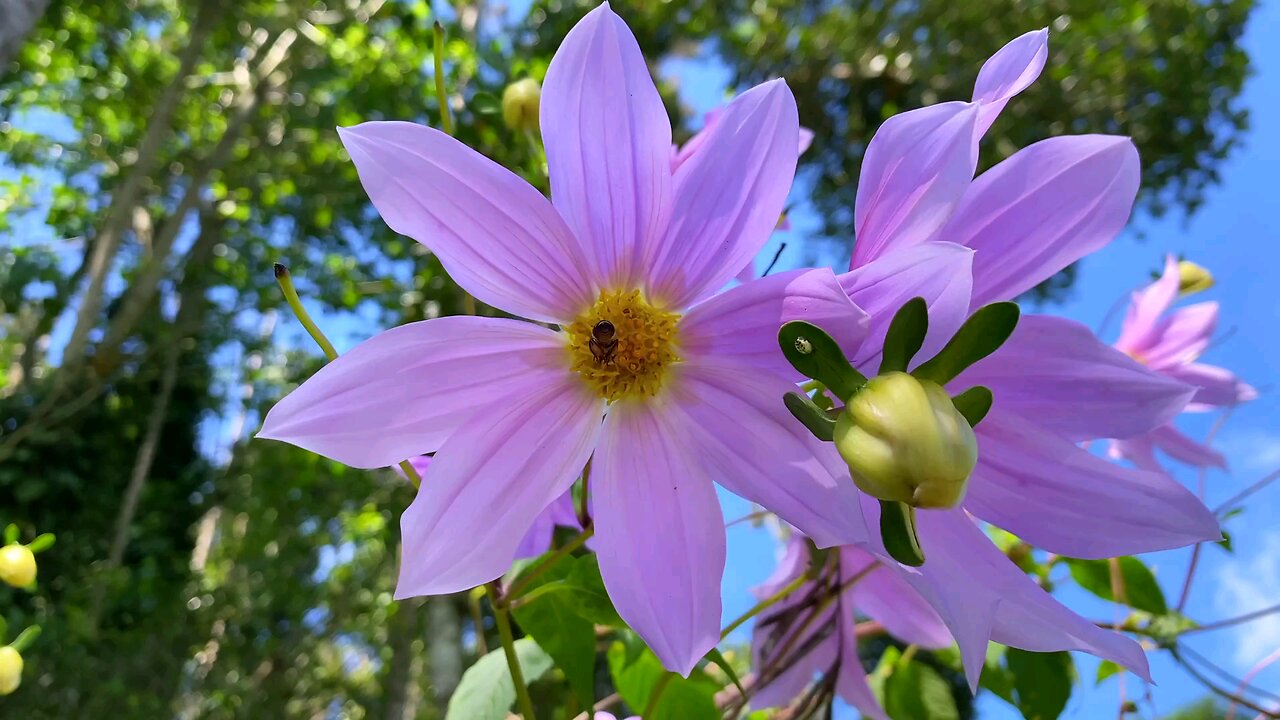Premium Only Content

"Exploring Dahlia imperialis: A Giant Among Flowers"
Dahlia imperialis, commonly known as the tree dahlia, is a towering, perennial flowering plant native to Central America, especially Mexico and Guatemala. It belongs to the Asteraceae family, which includes sunflowers and daisies. Here's an overview:
Description:
Dahlia imperialis can grow impressively tall, reaching up to 6–10 meters (20–33 feet) in height, giving it the name "tree dahlia."
The plant has hollow, bamboo-like stems and large, pinnate leaves that can grow to about 1 meter long.
It blooms in late autumn or early winter with large, pendulous, pale lavender or pinkish-purple flowers, each up to 20 cm across. The flowers resemble those of garden dahlias but grow at the tops of tall stems.
Its height and late bloom time make it a striking sight in gardens.
Habitat and Cultivation:
Native to higher elevations in Central America, Dahlia imperialis thrives in cool, mountainous regions but can be grown in temperate climates with mild winters.
It prefers well-drained soil and a sunny location. In colder climates, frost can damage its stems, so protection or growing in sheltered areas is often necessary.
Uses:
Although primarily cultivated for its ornamental beauty, Dahlia imperialis is also used in traditional Mexican medicine. The hollow stems store water, and parts of the plant are believed to have medicinal properties, though they are not commonly used in mainstream herbalism.
The plant has edible tubers, similar to other dahlia species, which have been historically used as a food source.
Cultural Significance:
In Mexican culture, tree dahlias are called "acocotli," and they have historical significance as a cultivated plant by the Aztecs.
This combination of dramatic height, beautiful blooms, and cultural heritage makes Dahlia imperialis a unique and valuable plant in ornamental gardens.
-
 LIVE
LIVE
Barry Cunningham
7 hours agoPRESIDENT TRUMP HAS DEMOCRATS IN SHAMBLES AND LEE GREENWOOD INTERVIEW!
4,907 watching -
 LIVE
LIVE
Glenn Greenwald
3 hours agoWhy are Big Tech Execs Integrating into the US Military? CBS Pays Trump $15 Million: With FIRE's Nico Perrino; Diddy Verdict Locals Exclusive | SYSTEM UPDATE #480
3,557 watching -
 LIVE
LIVE
The Jimmy Dore Show
2 hours agoDiddy ACQUITTED! CDC Vaxx Panel Votes to Remove Mercury from Flu Shot! w/ Mary Holland
11,634 watching -
 LIVE
LIVE
Melonie Mac
1 hour agoGo Boom Live Ep 53!
212 watching -
 DVR
DVR
RiftTV
3 hours agoIs The Catholic Church the TRUE CHURCH of Jesus Christ? | The Rift | Guest: Timothy Gordon
5.23K2 -
 1:51:26
1:51:26
Andres Meneses
13 hours agoInside the Mind of Zuby: The Future of Bitcoin and Free Thought
5 -
 35:50
35:50
The Kevin Trudeau Show Limitless
10 hours agoHow to Start a Small Business or Side Hustle in 2025 Mark Kohler's Secrets!
2781 -
 9:18
9:18
Freedom Frontline
2 hours agoChaos Erupts When MTG, AOC & Jasmine Crockett Face Off in Heated Hearing
14 -
 1:04:35
1:04:35
BonginoReport
3 hours agoTrump Ca$hes In After Suing FAKE NEWS CBS - Nightly Scroll w/ Hayley Caronia (Ep.82) - 07/02/2025
82.5K37 -
 1:09:01
1:09:01
TheCrucible
4 hours agoThe Extravaganza! EP: 13 (7/02/25)
82.5K11